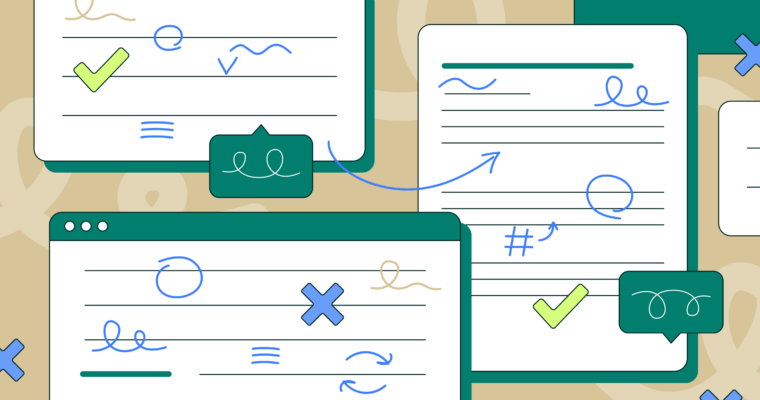
Table of contents
- What is editing?
- Types of editing
- When should you edit your own writing?
- How to edit your writing in 3 steps
- Editing FAQs
Good, clear writing—whether it’s for an email, a résumé, a term paper, or a creative project—is not just writing. As tempting as it can be to consider the job of writing something finished as soon as you’ve done the hard work of getting your words down on the page, one of the best skills you can develop as a writer is the ability to edit your own work, from rewriting sections of a first draft to giving a final polish to your document. And if you know you’re going to be giving yourself the opportunity to go back through what you’ve written and make sure your ideas are clear and well organized, you free yourself up to write a fluid first draft. Read on for an explanation of what editing is and how to apply it to your own writing.
What is editing?
Editing is the process of reviewing writing to ensure that it communicates its point clearly and as intended, and that it is free of errors. Simply put, editing means making sure that you’ve said what you mean, neatly and cleanly. Although editing your own writing is different from what professional editors do, it is useful to understand the different levels of editing that exist in the world of publishing, as well as the order that these editing steps are performed in, so you can get a sense of the process you can and should apply to your own documents.
In general, editing should progress from the broadest strokes to the most detailed—after all, there’s no point in making sure a word is hyphenated correctly if you’re not even sure you’re keeping the sentence it appears in!
Types of editing
Substantive editing
The first step of editing is called substantive or developmental editing. When an editor is giving a substantive edit to a draft, their focus is on the text as a whole. It deals with the overall organization of a piece of writing as well as questions of voice, tone, and intended audience.
Copyediting
After a piece of writing is in good shape organizationally, and the writer and substantive editor are happy with the language and flow of ideas in it, it’s time for copyediting. The copy editor is responsible for correcting any errors in grammar, syntax, usage, spelling, and punctuation, as well as making sure the piece is consistent in its handling of things like capitalization, hyphenation, abbreviations, and numbers. For academic or technical writing, this may also be the stage when citations are properly formatted. In many publishing contexts, copy editors are also responsible for making sure that any factual material in a piece of writing is accurate.
Proofreading
Proofreading is the last pass of editing. A proofreader looks at a piece of text from the standpoint of how it will appear to a reader, whether that’s in a print layout with images, a blog post, or another format. This is the stage for catching typos that were missed in earlier passes or introduced late, as well as when the final formatting is checked—line breaks, margins, and so on.
When should you edit your own writing?
Any time you’ve written something that you want to make sure appears in its best possible form, going through the steps of editing is a good idea. Whether it’s a professional email, a cover letter, a résumé, an essay assignment for a class, or a piece of writing you’re submitting for publication, you can adapt the editing process to your own purposes.
How to edit your writing in 3 steps
After you have a finished draft of whatever document you’re working on, you can begin the process of editing. Because you’ll be acting as the substantive editor, the copy editor, and the proofreader of your own work, it’s a good idea to take a break between every stage of the writing and editing process, and then return to your document after a little time has passed to look at it anew.
Remember, it generally makes sense to go from the biggest kinds of changes to the smallest ones. What follows are some steps you can take to edit anything you’ve written, listed as specific things to look out for during stages adapted from the three levels of professional editing laid out above. If a step doesn’t apply to the document you’re working on, skip it.
1. First pass: Substantive editing
- Make sure your introduction accurately sets up the points you ended up making.
- Ensure any evidence you’re presenting backs up your arguments.
- Is the document as a whole logically organized? If there are similar elements in various spots, now is the time to reorganize the piece so that they appear together.
- Watch out for repetitive and confusing language and ideas.
- Read with an eye for conciseness, and cut anything that is extraneous or redundant.
- Clarify anything that is vague or unclear.
- Make sure you are writing for the same audience throughout. For example, are you assuming a consistent level of familiarity with your subject from beginning to end of your piece?
- Notice your tone. If you find that some sentences are more formal and others more conversational, decide which makes the most sense for the purpose of the document and rewrite those that don’t conform.
- Pay attention to sequencing and transitions. Your ideas should flow from sentence to sentence and paragraph to paragraph in a way that’s easy to follow.
2. Second pass: Copyediting
- At this stage, you’re switching from a focus on your document as a whole to a more detailed approach.
- Read the piece out loud, listening for repetitive words along with awkward rhythms.
- Make sure you’ve been thoughtful when it comes to word choice.
- Think about varying the length and structure of your sentences.
- Look up words in a dictionary and/or run the text through a spell-checker to correct any spelling mistakes.
- Fix any punctuation errors.
- Resolve grammatical issues such as unparallel structure, subject-verb disagreement, verb tense problems, and improper use of conjunctions or prepositions.
- Make sure any facts you’re presenting—dates, titles, company names—are accurate.
3. Third pass: Proofreading
- Do a final readthrough to catch any lingering typos or other kinds of errors.
- Tidy up your formatting. This means confirming that you’ve been consistent in the way you’ve applied italics and other font treatments, as well as the way you’ve handled headings and subheadings, margins, indentation, line spacing, color, etc.
Editing FAQs
What is editing?
Editing is the process of going through text to ensure that it communicates what the writer wants it to and is free of errors. In general, editing progresses from the broadest level to the most detailed.
What are the main levels of professional editing?
There are three main levels of professional editing. Substantive or developmental editing focuses on the organization of a piece of writing as a whole, as well as questions of voice and audience. Copyediting goes through a text sentence by sentence with a focus on spelling, grammar, punctuation, syntax, and, often, fact-checking. Proofreading looks at the copy in its final, laid-out form and is the last chance to catch errors and finalize formatting.
What kinds of writing should I be sure to edit myself?
Anytime you’ve written something that you want to be sure is seen in the best possible light by whomever you’re sending it to, you should edit it. This can include professional correspondence, academic papers, résumés, and more.






